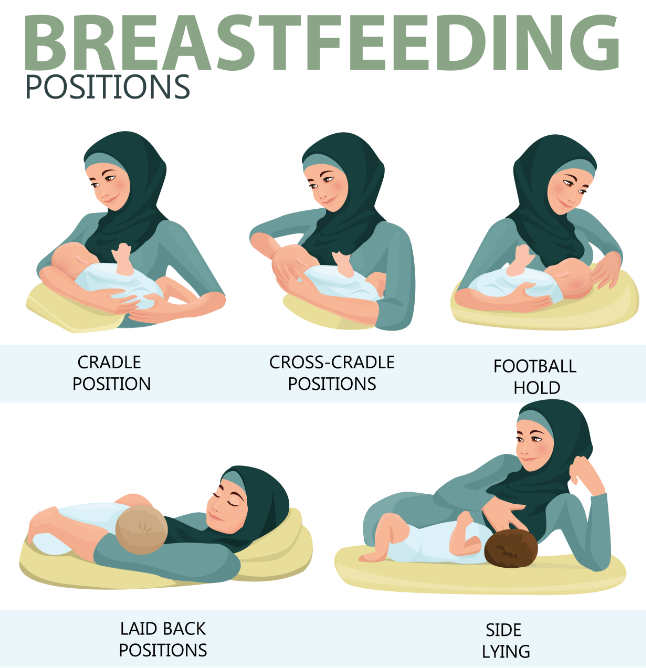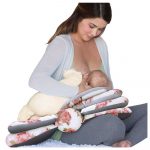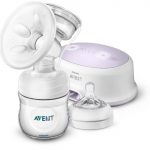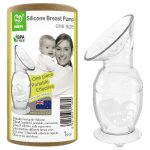The notion that boobs plus baby equal breastfeeding bliss is a nice one. The reality for many mothers, though, is that the whole business takes practice from both of you. If you’re able to breastfeed and choose to do so, you might find you need some guidance, at least initially. Which is where we come in…
View this post on Instagram
According to the NHS, 73% of new mums begin by breastfeeding their babies, and many find it to be a relaxing, bonding experience. That said, it’s not unusual to experience some difficulty getting started or a few hiccups along the way. Whether your baby is struggling to latch on, you’ve bought a breast pump and don’t know how to use it (or are just downright terrified by the noise it makes), or could simply use some friendly advice, you’re in the right place.
The first thing to remember is that while things aren’t always easy, there are a wealth of good reasons to give your baby breastmilk. Here are a few to give you a morale boost in the difficult early weeks:
Benefits of breastfeeding:
- Breastmilk is a complete meal, perfectly designed for your baby
- It can help reduce the risk of infections, diarrhoea and vomiting, and even childhood leukaemia and sudden infant death syndrome
- It helps guard against conditions later in life such as obesity and diabetes
- In mums, it can reduce your risk of osteoporosis, breast and ovarian cancer, heart disease and obesity
- It’s free and available whenever you need it
- It can help develop the bond between mum and baby
Getting started:
Unfortunately, it isn’t usually as simple as offering your baby a breast and telling them to get on with it while you binge on box sets/eat biscuits/drink tea (although those days will come). It can take a bit of time for you and your baby to learn the ropes.
Getting established is like learning any new skill; it can be daunting at first and it’s easy to get dispirited when your baby doesn’t guzzle away on their first attempt, but with a little preparation and perseverance, it usually gets much easier for both you and your baby.
Try to research as much as possible before baby arrives, but if your baby’s already here, don’t panic. A bit of prep always helps but you can’t really get a feel for it all until you can actually get on with it.
Breastfeeding pillows
These can be a real help for many feeding positions and can help you support your baby in the early days, while you develop the knack. The pillows come in all shapes and sizes, from those that you can use as a pregnancy pillow and double up for feeding your baby later, to those that tie neatly around your waist to make picking your baby up for a feed easy. Have a look at a few different models to see what might suit you.
Breastfeeding positions
There are probably more of these than you realise (as a newbie, at least), and it may take a bit of shifting around before you find the one that works best for you. Don’t worry if it feels a bit awkward at first – just get comfortable, make sure your baby’s head and body are supported in a straight line so they can swallow easily, and the rest will come with practice.
- Cradle hold– as the name suggests, cradle your baby across your lap, using the arm on the side that your baby is feeding to support her. Rest the head in the crook of your elbow and let the rest of her lie on your hand. Bring her forward to the breast, rather than leaning forward.
- Rugby hold– place a pillow beside you on the side you intend your baby to feed on and tuck your baby’s body beside you, her hip to yours, under your arm. Support the head with your hand and guide her to the nipple. This a useful position if you have twins.
- Lying down– a good position for night feeds, or if you’re recovering from a birth injury or caesarean. Lie on your side and place your baby’s body parallel with yours and tuck a pillow behind them for extra support.

Is my baby latched properly?
When you start out, it’s hard to know whether your baby is latching on correctly. There are a few things to remember:
- Tummy to tummy: hold her so her tummy is facing into your own, so she doesn’t have to turn her head to feed
- Nose to nipple: bring her nose up to your nipple (not the other way round or you’ll do your back in)
- Wait for the gape: when she opens her mouth wide, bring her onto the breast so she gets a good mouthful
Signs of a good latch include:
- Full cheeks as she is feeding
- You can hear her swallowing but she isn’t making any clicking or smacking noises
- Your baby is gaining weight and you’re seeing lots of wet nappies
If you’ve tried adjusting your feeding position and technique but your baby still is not latching on properly, there could be something else stopping her from feeding correctly. It’s possible she could have thursh, which babies can easily pick up in the birth canal and affects many newborns, or it could be reflux or a medical condition such as tongue tie or a cleft palate (although a cleft palate is usually picked up earlier).
Keep persevering one feed at a time and try to find local clinics.
You know your baby better than anyone else, so if you feel something isn’t right with your latch, speak to your health visitor or GP and they will be able to advise you. Although some pain is to be expected when you start (and don’t worry, nipples do eventually toughen up) pain can also indicate that something is wrong. Listen to your body and trust your instincts.
How many feeds does my baby need each day?
This will change as your baby grows. At first, it will be around 12 feeds in 24 hours and you could be feeding hourly in some parts of the day, but this will gradually reduce to around every three hours and then every four. The best thing is to be guided by your baby.
Signs a baby is hungry
- Sucking her fists
- Making chomping motions with her mouth
- Rooting for the nipple (embarrassingly, she will try this on anyone holding her at the time)
- Wriggling and looking around
- Crying (this is one of the last signs so don’t wait for her to start yelling before you feed her)
Foods to avoid
Eating a varied and nutritious diet is very important for keeping you and your baby healthy. There are few hard-and-fast rules on foods to avoid in general it’s much less prescriptive than the dietary dos and don’ts of pregnancy, you’ll be pleased to hear.
Caffeine and breastfeeding
NHS advice is to limit your caffeine intake to 200mg or less per day, which amounts roughly to two cups of instant coffee. You may be feeling tired as sin, but it’s thought that the caffeine you consume could keep your baby awake – which isn’t what anyone with a newborn is aiming for.
However, a recent review by the University of Warwick has highlighted the need for more extensive research on this subject. The study, by a research team from the university’s medical school, has found no real evidence of positive or negative effects of maternal caffeine consumption on a breastfed baby. But before you stick the kettle on, the team isn’t suggesting that caffeine has no effect at all – it just doesn’t think there are sufficient studies of good quality to inform new mothers about how much caffeine they can actually have.
Lead researcher on the team, Aimee McCreedy said: “It’s understandable that the NHS suggests that breastfeeding mothers restrict their caffeine intake to half of the usual recommended allowance for adults. This cautious approach likely reflects the paucity of good evidence. However, the lack of evidence is surprising given the promotion of exclusive for the first six months from birth and the importance of infant nutrition for health.”
Dr Yen-Fu Chen, the principal research fellow at Warwick Medical School said: “There is ample opportunity for well-designed studies to examine the effects of caffeine intake by mothers on their infants, and such research is overdue given the importance of maternal and child well-being at this crucial stage of life.”
So, the upshot is, there’s no real evidence to suggest 200mg is the correct limit for caffeine intake, but not enough research has been done to provide a more accurate one. Which means it’s probably best to stick to decaf for the most part… Sorry.
Is it safe to drink alcohol while breastfeeding?
It’s best to limit your alcohol intake, though the occasional glass is alright. The NHS recommends you limit your intake to two units once or twice a week. That’s a couple of small glasses of wine, a pint of beer, or two single measures of spirits.
How do I express milk?
Expressing breastmilk can give you flexibility and some respite if you’re finding feeding painful. Whether you express by hand, or with a breast pump allows you to transfer your breast milk into a bottle.
Combining breast and bottle feeding is known as mixed feeding and allows other people, such as your partner, to feed the baby with a bottle yup, this can mean getting your partner to take on a night feed, which means more sleep for you!)
Don’t forget that if you’re using a breast pump and bottles you will need to invest in a steriliser too.
As well as giving you a break from exclusive breastfeeding of your baby, feeding them expressed milk allows you a bit of freedom from avoiding alcohol and certain foods. For example, if you have a night out planned, you can give your baby milk that you’ve expressed beforehand to eliminate any chances of alcohol entering her system through your breast milk.
Expressing can also boost your milk supply, relieve breast engorgement and help a premature baby who is yet to develop their suckling reflux.
Breastfeeding twins
If you’re about to be the mother of twins, you may be wondering how you can feed two babies. Fear not – it is possible when you find a technique, position and routine that works for you including help with tandem feeding and tips for feeding premature twins.
Feeding premature baby or baby in special care
If you had a premature birth or your baby is in a neonatal or special care baby unit for another reason, it might feel like the odds are stacked against you. However, there’s lots you can do to ensure your baby gets the great start that breastmilk offers if you decide you want to give it a go.
If you want to breastfeed your premature baby, or baby in special care make sure you let the unit staff know from the beginning, so you’re all on the same page.
Lots of very premature babies find it difficult to suck, so you may have to express milk and feed your baby using a cup or syringe to begin with. Your baby might also need to be given special newborn formula at first to ‘top her up’ and may need to be tube-fed, too.
How much should my baby weigh?
Your baby will lose some of their birth weight in their first few days but this is nothing to be concerned about. Babies are born with some extra fluid and the loss of this is entirely normal. About 80% of newborns will reach their birth weight again within their first two weeks, although this may take a little longer for some.
Your baby will be measured at certain ages to check that she’s gaining weight at the expected rate. If her weight gain has slowed, it could be for a number of reasons, and your midwives and health visitors will be able to help you get things back on course.
Although your baby’s growth will be continuous throughout their first few years, there will be growth spurts when they grow more rapidly. There are some signs to look out for other than your baby literally growing overnight, such as erratic sleep patterns and clinginess or grumpiness.
How to stop breastfeeding
There is no set time for stopping, really. It’s up to you to decide when to wean your baby off the breast, based on what’s best for both of you.
The consensus among experts, including the NHS and the World Health Organisation (WHO), is that babies should be exclusively breastfed for the first six months of their lives. Breastmilk provides babies with all of the vital nutrients and energy they need to grow and develop. Breastmilk (and formula milk) is also considered better for a young baby’s developing digestive system than solid foods, which is why you’re advised to delay weaning until at least six months.
The WHO recommends you continue, alongside giving your child solid foods, until they are two years old. However, for some mothers, doing so for this long is either impractical or they (understandably) just don’t fancy it. The good news is that everything gets easier the older your baby gets. Not only will you both be old hands at the whole thing but as she drops feeds, it all becomes a bit easier to manage, too. But if you feel you’re ready to start weaning off the breast you can pat yourself on the back no matter how far you got. Every little helps, as they say.
Other articles you might be interested in:
How to Transition from Breastfeeding to Solids?
Can I Return to Work and Continue Breastfeeding? The Answer is Yes!













Undeniably believe that which you said. Your favorite justification appeared to be on the internet the easiest thing to be mindful of. I say to you, I certainly get irked even as folks think about concerns that they just do not recognise about. You controlled to hit the nail upon the top and also outlined out the entire thing without having side effect , other folks could take a signal. Will likely be back to get more. Thanks
Thanks for your helpful post. In recent times, I have come to understand that the particular symptoms of mesothelioma cancer are caused by a build up connected fluid between the lining of the lung and the chest muscles cavity. The ailment may start inside chest area and get distributed to other parts of the body. Other symptoms of pleural mesothelioma cancer include fat reduction, severe breathing in trouble, vomiting, difficulty swallowing, and inflammation of the neck and face areas. It must be noted that some people having the disease tend not to experience any serious symptoms at all.
It is my belief that mesothelioma will be the most dangerous cancer. It has unusual qualities. The more I actually look at it the greater I am sure it does not conduct itself like a real solid human cancer. In case mesothelioma is actually a rogue virus-like infection, hence there is the possibility of developing a vaccine as well as offering vaccination to asbestos subjected people who are really at high risk connected with developing foreseeable future asbestos related malignancies. Thanks for expressing your ideas on this important health issue.
I’m extremely impressed with your writing talents as neatly as with the format in your weblog. Is that this a paid subject or did you modify it your self? Anyway keep up the nice quality writing, it is rare to look a great weblog like this one today..
The things i have generally told men and women is that when evaluating a good on the net electronics store, there are a few issues that you have to think about. First and foremost, you would like to make sure to look for a reputable and in addition, reliable retail store that has got great testimonials and rankings from other individuals and marketplace advisors. This will make certain you are dealing with a well-known store that gives good services and support to its patrons. Thanks for sharing your thinking on this blog.
Amazing blog! Do you have any tips for aspiring writers? I’m planning to start my own blog soon but I’m a little lost on everything. Would you propose starting with a free platform like WordPress or go for a paid option? There are so many options out there that I’m totally confused .. Any ideas? Appreciate it!
naturally like your website but you have to check the spelling on several of your posts. Many of them are rife with spelling problems and I find it very troublesome to tell the truth nevertheless I will surely come back again.
Hello! I’ve been following your website for some time now and finally got the bravery to go ahead and give you a shout out from Lubbock Tx! Just wanted to say keep up the fantastic job!
Please let me know if you’re looking for a article author for your weblog. You have some really great articles and I believe I would be a good asset. If you ever want to take some of the load off, I’d love to write some articles for your blog in exchange for a link back to mine. Please shoot me an e-mail if interested. Thanks!
I must admit, this post is really good. In fact, it’s one of the best I’ve seen in quite some time.
http://www.factorytinsigns.com is 100 Trusted Global Metal Vintage Tin Signs Online Shop. We have been selling art and décor online worldwide since 2008. Started in Sydney, Australia. 2000+ Tin Beer Signs, Outdoor Metal Wall Art, Business Tin Signs, Vintage Metal Signs to choose from. 100 Premium Quality Artwork. Up-to 40 OFF Sale Store-wide. Fast Shipping USA, Canada, UK, Australia, New Zealand, Europe.
This is one of the best posts I’ve came across in quite a while. Nice work.
I’m blown away by the quality of this content! The author has obviously put a tremendous amount of effort into exploring and structuring the information. It’s inspiring to come across an article that not only offers useful information but also keeps the readers captivated from start to finish. Kudos to him for making such a masterpiece!
Thanks a bunch for sharing this with all of us you really know what you’re talking about! Bookmarked. Kindly also visit my website =). We could have a link exchange contract between us!
Throughout the awesome scheme of things you actually secure an A for effort. Exactly where you actually confused me was first on all the particulars. As it is said, the devil is in the details… And that couldn’t be much more true in this article. Having said that, let me tell you just what did give good results. The article (parts of it) is rather powerful and this is most likely the reason why I am making an effort to opine. I do not really make it a regular habit of doing that. Second, while I can certainly see the leaps in reasoning you make, I am not necessarily sure of how you appear to connect the points which in turn make the actual conclusion. For now I will, no doubt yield to your point however wish in the foreseeable future you link your facts better.
Thanks for some other great post. The place else could anyone get that kind of information in such an ideal method of writing? I’ve a presentation subsequent week, and I’m at the search for such info.
This is a great page. It’s very informative and well organized. I’ll come back from time to time for more posts like this one.
I have learned quite a few important things via your post. I’d also like to express that there can be situation where you will make application for a loan and don’t need a cosigner such as a Fed Student Support Loan. When you are getting a loan through a classic bank or investment company then you need to be prepared to have a cosigner ready to make it easier for you. The lenders will base their very own decision over a few components but the largest will be your credit worthiness. There are some loan companies that will furthermore look at your work history and come to a decision based on that but in many instances it will depend on your report.
It is indeed my belief that mesothelioma can be the most deadly cancer. It contains unusual characteristics. The more I actually look at it the more I am persuaded it does not act like a true solid cells cancer. In case mesothelioma is often a rogue virus-like infection, in that case there is the possibility of developing a vaccine plus offering vaccination to asbestos uncovered people who are vulnerable to high risk of developing foreseeable future asbestos related malignancies. Thanks for expressing your ideas for this important ailment.
Hi are using WordPress for your blog platform? I’m new to the blog world but I’m trying to get started and create my own. Do you require any html coding knowledge to make your own blog? Any help would be greatly appreciated!
Nice weblog here! Additionally your web site a lot up very fast! What host are you using? Can I get your associate link in your host? I desire my web site loaded up as quickly as yours lol
There is noticeably a bundle to find out about this. I assume you made sure nice factors in features also.
I’ve observed that in the world the present day, video games include the latest fad with kids of all ages. Many times it may be impossible to drag young kids away from the video games. If you want the best of both worlds, there are lots of educational games for kids. Thanks for your post.
I additionally believe that mesothelioma cancer is a exceptional form of many forms of cancer that is typically found in those people previously exposed to asbestos. Cancerous tissues form inside mesothelium, which is a safety lining which covers almost all of the body’s areas. These cells typically form inside the lining with the lungs, abdominal area, or the sac which encircles one’s heart. Thanks for revealing your ideas.
One thing I’d prefer to say is car insurance canceling is a dreaded experience so if you’re doing the right things like a driver you simply won’t get one. Some individuals do obtain notice that they are officially dumped by their particular insurance company they then have to scramble to get extra insurance from a cancellation. Low-priced auto insurance rates usually are hard to get from a cancellation. Knowing the main reasons concerning the auto insurance termination can help car owners prevent completely losing in one of the most significant privileges available. Thanks for the ideas shared by your blog.
I’m glad I discovered this page. I was looking for something else when I stumbled on it. Nice work.
I?m impressed, I must say. Actually rarely do I encounter a weblog that?s each educative and entertaining, and let me tell you, you have got hit the nail on the head. Your idea is excellent; the difficulty is something that not sufficient individuals are talking intelligently about. I am very joyful that I stumbled across this in my search for one thing regarding this.
Thanks for your interesting article. One other problem is that mesothelioma cancer is generally brought on by the breathing of materials from mesothelioma, which is a extremely dangerous material. Its commonly witnessed among workers in the structure industry who may have long experience of asbestos. It is also caused by living in asbestos insulated buildings for an extended time of time, Genetic makeup plays a crucial role, and some consumers are more vulnerable to the risk as compared to others.
Hey there! I know this is somewhat off topic but I was wondering which blog platform are you using for this website? I’m getting fed up of WordPress because I’ve had problems with hackers and I’m looking at alternatives for another platform. I would be great if you could point me in the direction of a good platform.
Throughout this great design of things you’ll receive an A+ just for effort and hard work. Exactly where you misplaced me personally was first in the facts. You know, as the maxim goes, the devil is in the details… And that could not be much more correct at this point. Having said that, let me reveal to you exactly what did deliver the results. The article (parts of it) is definitely very powerful which is possibly the reason why I am making an effort in order to comment. I do not really make it a regular habit of doing that. Next, despite the fact that I can see a leaps in logic you make, I am not certain of just how you appear to connect the points which inturn produce the final result. For right now I shall subscribe to your issue but trust in the near future you connect your dots much better.
Some tips i have generally told folks is that when looking for a good internet electronics retail store, there are a few components that you have to think about. First and foremost, you need to make sure to locate a reputable and reliable shop that has gotten great assessments and ratings from other shoppers and marketplace analysts. This will make certain you are getting along with a well-known store to provide good service and support to its patrons. Thanks for sharing your opinions on this web site.
Thanks for sharing superb informations. Your website is very cool. I am impressed by the details that you?ve on this blog. It reveals how nicely you understand this subject. Bookmarked this website page, will come back for extra articles. You, my pal, ROCK! I found just the info I already searched all over the place and simply could not come across. What a great website.
Hey there! Someone in my Myspace group shared this site with us so I came to check it out. I’m definitely enjoying the information. I’m bookmarking and will be tweeting this to my followers! Excellent blog and terrific style and design.
I believe one of your advertisings triggered my web browser to resize, you might want to put that on your blacklist.
After study a few of the blog posts on your website now, and I actually like your means of blogging. I bookmarked it to my bookmark web site listing and might be checking again soon. Pls try my website as well and let me know what you think.
Good day! I know this is somewhat off topic but I was wondering if you knew where I could get a captcha plugin for my comment form? I’m using the same blog platform as yours and I’m having problems finding one? Thanks a lot!
This really answered my problem, thank you!
I’m bookmarking this for future reference. The information here is just too valuable!
Nice post. This wasn’t what I was looking for but I still liked reading it.
I’m really impressed with your writing skills and also with the layout on your weblog. Is this a paid theme or did you modify it yourself? Anyway keep up the nice quality writing, it?s rare to see a great blog like this one nowadays..
I acquired more interesting things on this weight reduction issue. One issue is that good nutrition is highly vital any time dieting. An enormous reduction in fast foods, sugary foods, fried foods, sugary foods, beef, and white flour products could be necessary. Holding wastes parasites, and contaminants may prevent desired goals for losing fat. While certain drugs in the short term solve the matter, the nasty side effects will not be worth it, they usually never present more than a short-lived solution. This can be a known idea that 95 of diet plans fail. Many thanks for sharing your ideas on this web site.
It?s actually a cool and useful piece of info. I am glad that you shared this helpful info with us. Please keep us informed like this. Thanks for sharing.
Hi there just wanted to give you a quick heads up and let you know a few of the pictures aren’t loading properly. I’m not sure why but I think its a linking issue. I’ve tried it in two different browsers and both show the same results.
Hello! Do you know if they make any plugins to help with SEO? I’m trying to get my blog to rank for some targeted keywords but I’m not seeing very good gains. If you know of any please share. Thank you!
I am really impressed with your writing skills and also with the layout on your blog. Is this a paid theme or did you modify it yourself? Either way keep up the excellent quality writing, it?s rare to see a nice blog like this one today..
I appreciate, cause I found exactly what I was looking for. You’ve ended my 4 day long hunt! God Bless you man. Have a nice day. Bye
The root of your writing while sounding reasonable originally, did not really work well with me personally after some time. Someplace throughout the sentences you actually were able to make me a believer unfortunately just for a while. I still have got a problem with your jumps in assumptions and one would do well to fill in those gaps. When you actually can accomplish that, I will certainly be impressed.
It’s the best time to make some plans for the future and it’s time to be happy. I have read this post and if I could I wish to suggest you some interesting things or tips. Maybe you could write next articles referring to this article. I want to read even more things about it!
This article is absolutely incredible! The author has done a fantastic job of delivering the information in an compelling and enlightening manner. I can’t thank her enough for sharing such precious insights that have undoubtedly enhanced my understanding in this topic. Bravo to him for producing such a work of art!
There are some fascinating closing dates on this article but I don?t know if I see all of them center to heart. There may be some validity however I’ll take maintain opinion until I look into it further. Good article , thanks and we want extra! Added to FeedBurner as effectively
Good ? I should definitely pronounce, impressed with your site. I had no trouble navigating through all tabs and related information ended up being truly simple to do to access. I recently found what I hoped for before you know it at all. Reasonably unusual. Is likely to appreciate it for those who add forums or anything, site theme . a tones way for your client to communicate. Excellent task..
Excellent post. I used to be checking constantly this blog and I am inspired! Very useful information specially the ultimate phase 🙂 I maintain such info much. I was looking for this particular info for a long time. Thank you and good luck.
This really answered my downside, thanks!
Amazing! This blog looks exactly like my old one! It’s on a entirely different subject but it has pretty much the same layout and design. Superb choice of colors!
you’re really a good webmaster. The web site loading speed is amazing. It seems that you’re doing any unique trick. Also, The contents are masterpiece. you’ve done a fantastic job on this topic!
Definitely believe that which you said. Your favorite reason appeared to be on the web the simplest thing to be aware of. I say to you, I definitely get irked while people think about worries that they just do not know about. You managed to hit the nail upon the top and defined out the whole thing without having side effect , people could take a signal. Will likely be back to get more. Thanks
I am really inspired with your writing skills as neatly as with the format for your blog. Is that this a paid subject matter or did you customize it yourself? Either way keep up the nice high quality writing, it?s rare to see a nice blog like this one nowadays..
Thanks for expressing your ideas here. The other matter is that each time a problem occurs with a pc motherboard, people should not consider the risk with repairing the item themselves for if it is not done correctly it can lead to irreparable damage to the complete laptop. Most commonly it is safe just to approach your dealer of any laptop with the repair of that motherboard. They’ve technicians who definitely have an competence in dealing with pc motherboard complications and can make right prognosis and carry out repairs.
Aw, this was a very nice post. In thought I want to put in writing like this moreover ? taking time and actual effort to make a very good article? but what can I say? I procrastinate alot and under no circumstances appear to get something done.
I do believe that a property foreclosures can have a significant effect on the debtor’s life. House foreclosures can have a Six to ten years negative relation to a applicant’s credit report. A borrower who have applied for a mortgage or any kind of loans for that matter, knows that your worse credit rating can be, the more difficult it is to have a decent mortgage. In addition, it could possibly affect a new borrower’s power to find a decent place to let or rent, if that will become the alternative homes solution. Good blog post.
What i do not realize is actually how you’re not really much more well-liked than you might be right now. You’re very intelligent. You realize therefore considerably relating to this subject, produced me personally consider it from a lot of varied angles. Its like men and women aren’t fascinated unless it is one thing to do with Lady gaga! Your own stuffs excellent. Always maintain it up!
you’re in reality a excellent webmaster. The web site loading pace is amazing. It seems that you’re doing any unique trick. Moreover, The contents are masterwork. you have done a great process in this topic!
I have seen loads of useful items on your internet site about pcs. However, I’ve got the viewpoint that laptop computers are still less than powerful more than enough to be a option if you frequently do things that require loads of power, for instance video modifying. But for world-wide-web surfing, statement processing, and most other frequent computer work they are just great, provided you cannot mind your little friend screen size. Thank you sharing your opinions.
Hi there, You have done a great job. I?ll certainly digg it and personally recommend to my friends. I am confident they will be benefited from this web site.
Whats up very nice website!! Guy .. Excellent .. Amazing .. I’ll bookmark your site and take the feeds additionally?I’m glad to search out numerous useful info here within the put up, we need work out extra strategies on this regard, thank you for sharing. . . . . .
My partner and I stumbled over here from a different web page and thought I should check things out. I like what I see so now i am following you. Look forward to going over your web page repeatedly.
Thanks for your valuable post. Through the years, I have been able to understand that the actual symptoms of mesothelioma are caused by this build up associated fluid relating to the lining in the lung and the upper body cavity. The illness may start within the chest vicinity and spread to other areas of the body. Other symptoms of pleural mesothelioma cancer include fat loss, severe respiration trouble, vomiting, difficulty ingesting, and infection of the neck and face areas. It should be noted that some people living with the disease usually do not experience virtually any serious indicators at all.
very nice post, i certainly love this website, keep on it
Have you ever thought about writing an e-book or guest authoring on other websites? I have a blog based upon on the same ideas you discuss and would love to have you share some stories/information. I know my viewers would value your work. If you’re even remotely interested, feel free to send me an e-mail.
Hello, i think that i saw you visited my weblog so i came to ?return the favor?.I am attempting to find things to enhance my web site!I suppose its ok to use a few of your ideas!!
I think other site proprietors should take this web site as an model, very clean and magnificent user friendly style and design, as well as the content. You are an expert in this topic!
Great post. I used to be checking constantly this blog and I am impressed! Very helpful information particularly the ultimate part 🙂 I deal with such information much. I used to be seeking this particular information for a very long time. Thank you and good luck.
I’ve learned some new things from your blog post. Yet another thing to I have recognized is that in most cases, FSBO sellers can reject an individual. Remember, they might prefer not to ever use your companies. But if a person maintain a comfortable, professional partnership, offering guide and being in contact for around four to five weeks, you will usually be able to win a conversation. From there, a house listing follows. Thank you
I have learn a few just right stuff here. Certainly price bookmarking for revisiting. I surprise how so much effort you set to make this sort of great informative web site.
Thanks, I’ve recently been seeking for info about this subject for ages and yours is the best I have found so far.
Excellent goods from you, man. I have understand your stuff previous to and you’re just too excellent. I really like what you have acquired here, certainly like what you are saying and the way in which you say it. You make it enjoyable and you still take care of to keep it wise. I can’t wait to read far more from you. This is actually a wonderful website.
Thanks for the write-up. My partner and i have continually seen that a majority of people are needing to lose weight as they wish to look slim in addition to looking attractive. Nevertheless, they do not usually realize that there are other benefits for losing weight as well. Doctors insist that overweight people are afflicted with a variety of health conditions that can be directly attributed to their particular excess weight. Fortunately that people who are overweight and also suffering from various diseases can reduce the severity of the illnesses by losing weight. It is easy to see a continuous but noticeable improvement in health while even a minor amount of weight loss is achieved.
Great write-up, I?m regular visitor of one?s blog, maintain up the excellent operate, and It is going to be a regular visitor for a long time.
base medicale
crabs media
mehmet emre dinç
smile hair clinic
smile hair
nişantaşı
hairneva
asli tarcan global
sapphire
buk clinic
asli tarcan global